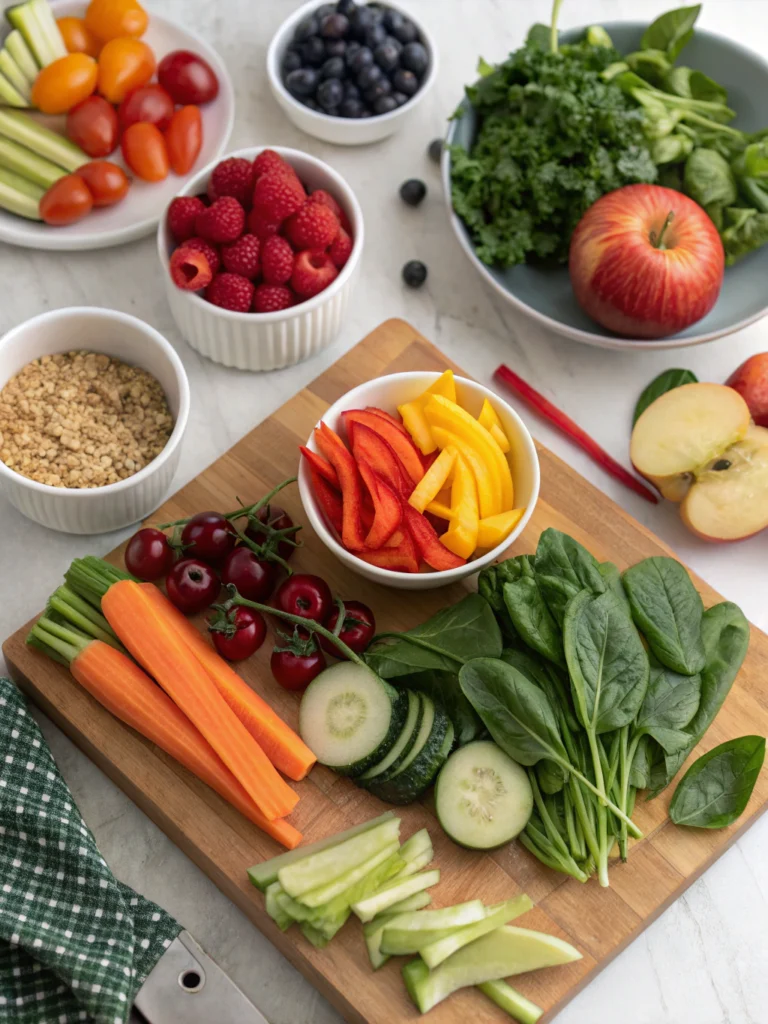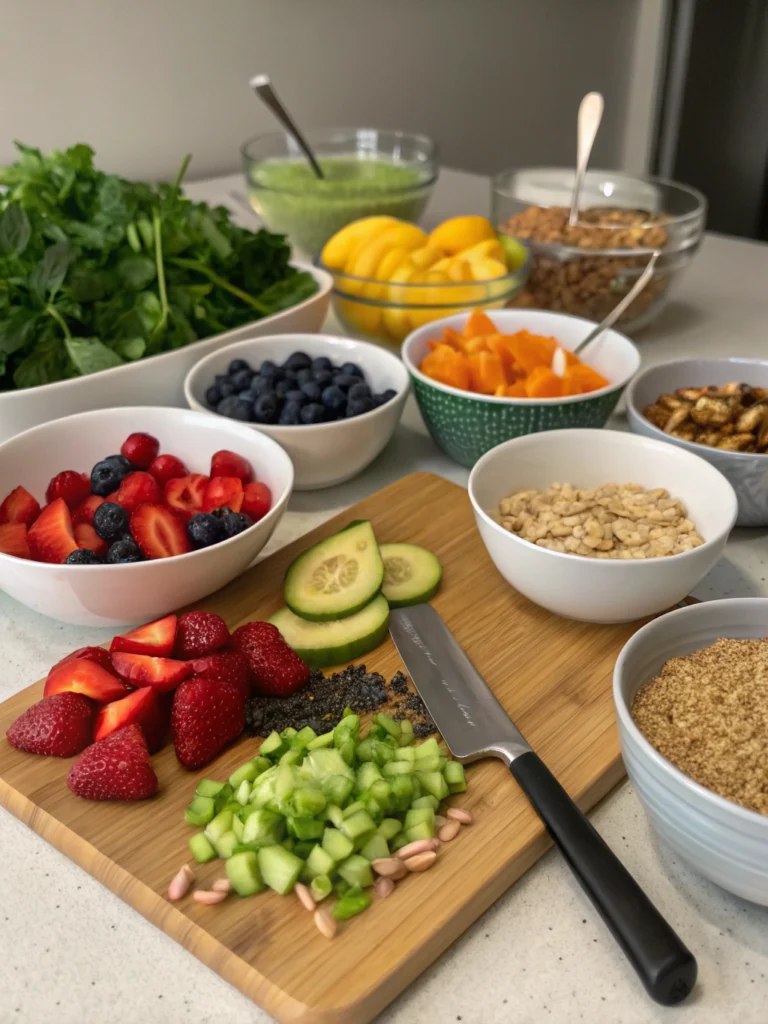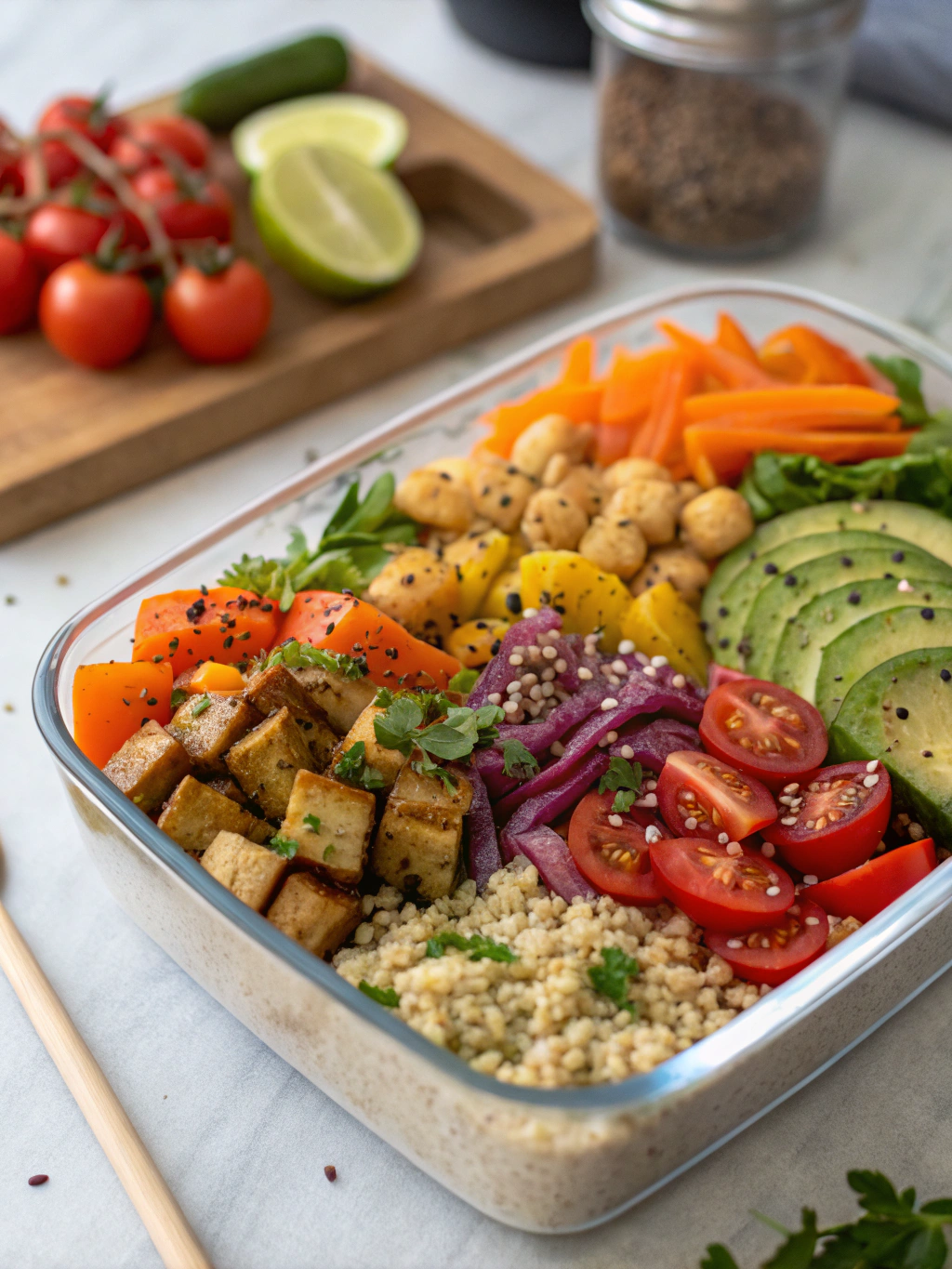Ever wondered how some people manage to eat healthy, plant-based meals all week while juggling demanding careers? Is it possible to maintain a vegan lifestyle without spending hours in the kitchen every day? The secret lies in effective vegan meal prep – a game-changing approach for time-strapped professionals.
This comprehensive vegan weekly meal plan will transform how you approach nutrition, saving you precious hours while ensuring you enjoy delicious, nutrient-dense meals throughout your hectic work week. Let’s dive into a practical 7-day strategy that combines efficiency with plant-powered goodness.
Why This Vegan Meal Prep Works
This high-protein vegan meal prep dinner is a game changer for busy weeknights.. It’s quick to prepare, fully plant-based, and loaded with nutrients that support energy and focus.
Ingredients List

Gathering your ingredients before starting your vegan meal prep session is crucial for efficiency. This comprehensive shopping list covers everything you’ll need for a successful week of plant-based eating:
Proteins
- 2 blocks of extra-firm tofu (organic preferred)
- 3 cans of various beans (black, chickpeas, kidney)
- 1 package of tempeh
- 1 cup of red lentils
- 1 cup of quinoa (complete protein source)
Fresh Produce
- 2 large sweet potatoes
- 1 head of broccoli
- 2 bell peppers (different colors for nutrient variety)
- 1 large zucchini
- 2 avocados (buy firm ones that will ripen mid-week)
- 1 bag of spinach
- 1 bag of mixed greens
- 2 carrots
- 1 cucumber
- 1 bunch of green onions
- 1 bunch of cilantro
- 1 container of cherry tomatoes
- 2 lemons
- 1 lime
- 2 bananas
- 2 apples
- 1 pint of berries
Pantry Staples
- Brown rice
- Rolled oats
- Chia seeds
- Flaxseeds
- Nutritional yeast
- Coconut milk (1 can)
- Olive oil
- Maple syrup
- Soy sauce or tamari
- Apple cider vinegar
- Dijon mustard
- Variety of spices (cumin, turmeric, paprika, garlic powder, etc.)
Substitution options: If tofu isn’t your preference, try seitan or additional legumes. Can’t find tempeh? Use more beans or lentils instead. For those avoiding soy, focus on legume-based proteins and consider hemp seeds as an additional protein source.
Timing
Set aside approximately 2-3 hours on Sunday for your main vegan meal prep session. This investment represents just 2% of your week but saves roughly 7-10 hours of weekday cooking time – a 300% return on your time investment!
Preparation time: 45-60 minutes (chopping, organizing, measuring)
Cooking time: 75-90 minutes (simultaneous cooking techniques)
Packaging time: 15-30 minutes (portioning and storing)
For optimal efficiency, plan a brief 30-minute mid-week refresh session (Wednesday evening) to prepare any fresh components for the latter part of the week.
Step-by-Step Instructions

Step 1: Strategic Preparation
Begin by preheating your oven to 400°F (200°C). While it heats, wash all produce thoroughly. Chop all vegetables that will be roasted or used in multiple dishes. Create an assembly line of containers for efficient packing later. Pro tip: Chop vegetables in consistent sizes for even cooking times.
Step 2: Start Batch Cooking Grains
Cook 2 cups of brown rice and 1 cup of quinoa according to package instructions. These will serve as the foundation for multiple meals. Using a rice cooker or Instant Pot for this step frees you to work on other components simultaneously. Add a bay leaf or veggie broth instead of water for enhanced flavor without extra calories.
Step 3: Prepare Protein Components
Press and cube tofu, then marinate in a mixture of soy sauce, garlic, and a touch of maple syrup. Rinse and drain beans. Prepare tempeh by slicing and creating a simple marinade with balsamic vinegar, tamari, and herbs. The key to flavorful tofu is removing excess moisture before marinating – press for at least 20 minutes for optimal texture.
Step 4: Roast Vegetables
Toss sweet potatoes, broccoli, and bell peppers with olive oil, salt, and preferred seasonings. Spread on baking sheets, ensuring vegetables aren’t overcrowded. Roast for 25-30 minutes, stirring halfway through. Different vegetables have different cooking times – start with denser vegetables like sweet potatoes, adding quicker-cooking items like bell peppers later.
Step 5: Prepare Tofu and Tempeh
While vegetables roast, cook marinated tofu in a non-stick pan until golden on all sides (about 10-15 minutes). Similarly, cook the tempeh until browned. Set aside to cool before packaging. For crispier tofu, toss with 1 tablespoon of cornstarch before cooking.
Step 6: Create Versatile Sauces
- Simple tahini sauce: Blend ¼ cup tahini, juice of one lemon, 1 garlic clove, and water to desired consistency
- Cilantro-lime dressing: Combine chopped cilantro, lime juice, olive oil, and a touch of maple syrup
- Creamy cashew sauce: Blend soaked cashews with nutritional yeast, garlic, and plant milk
Store sauces separately in small containers or mason jars. These transformative sauces will keep your meals exciting throughout the week, turning similar ingredients into distinctly different dining experiences.
Step 7: Assemble Breakfast Components
Prepare overnight oats base (oats, chia seeds, plant milk) to portion into 5 containers. Create energy ball mixture with dates, nuts, and oats for quick snacks. Refrigerate components that will be used for smoothies in easily accessible containers. Pre-portion smoothie ingredients in freezer bags for grab-and-blend convenience.
Step 8: Assemble Meal Containers
Create balanced meals by combining grains, proteins, and vegetables in meal prep containers. Aim for 4-5 lunch containers and 4-5 dinner options. Leave fresh components (avocado, certain sauces) separate until the day of consumption. Use the “template method” – each container should have approximately 1 cup grains, 3-4 oz protein, and 1-2 cups vegetables.
Step 9: Label and Store
Clearly label each container with contents and eat-by dates. Store properly in refrigerator, with Wednesday-Friday meals toward the back to maintain freshness longer. Freeze any portions planned for days 5-7 if you’re concerned about freshness. Use masking tape and permanent marker for easy labeling that won’t wash off in condensation.
Nutritional Information
This vegan meal prep plan is carefully balanced to provide optimal nutrition throughout your busy week. Each daily plan delivers approximately:
• Calories: 1,800-2,200 (adjustable based on individual needs)
• Protein: 60-75g (20% higher than the minimum recommendation for vegans)
• Fiber: 35-45g (exceeding the daily recommendation of 25-30g)
• Iron: 18-22mg (enhanced by vitamin C pairings for better absorption)
• Calcium: 800-1000mg (through strategic inclusion of fortified plant milks and leafy greens)
• Omega-3 fatty acids: 3-4g (via flaxseeds, chia seeds, and walnuts)
This plan provides complete nutrition without supplements, though a B12 supplement is generally recommended for all following a vegan diet. The meals maintain a balanced macronutrient ratio of approximately 55% carbohydrates, 25% fat, and 20% protein – ideal for sustained energy throughout demanding workdays.
Healthier Alternatives for the Recipe
While this meal plan is already health-optimized, here are modifications for specific dietary needs:
For lower carbohydrate needs: Replace half the grains with cauliflower rice or additional non-starchy vegetables. This modification reduces carbohydrates by approximately 30% while maintaining volume and satiety.
For higher protein requirements: Add 2 tablespoons of hemp seeds to each meal and increase tempeh/tofu portions by 25%. This simple adjustment adds approximately 10-15g of complete protein daily.
For oil-free preparation: Use water sautéing techniques and aquafaba (chickpea liquid) as an oil replacement in dressings. Steam vegetables instead of roasting and use parchment paper for any baking needs.
For gluten sensitivities: Ensure all soy sauce is replaced with tamari or coconut aminos, and verify that all other ingredients are certified gluten-free if cross-contamination is a concern.
Serving Suggestions
Transform your prepped components into exciting meals throughout the week with these serving ideas:
• Monday Buddha Bowl: Layer quinoa, roasted sweet potatoes, and tempeh with fresh greens. Top with tahini sauce and a sprinkle of nutritional yeast for a cheesy flavor.
• Tuesday Wrap Attack: Use large collard leaves or tortillas to wrap rice, beans, and vegetables with cilantro-lime dressing. Add fresh avocado just before eating.
• Wednesday Power Salad: Combine mixed greens with roasted vegetables, tofu, and a sprinkle of seeds. Drizzle with cashew dressing for a midweek energy boost.
• Thursday Grain Bowl: Warm brown rice topped with roasted vegetables, beans, and a generous pour of coconut-curry sauce creates a comforting dinner after a long day.
• Friday Fusion Tacos: Use lettuce cups or corn tortillas filled with your prepped components and fresh additions for an end-of-week celebration meal.
Common Mistakes to Avoid
- Overambitious planning: Starting with too many complex recipes leads to burnout. Begin with simple components that can be mixed and matched instead.
- Insufficient variety: Eating the exact same meal for multiple days leads to “meal prep fatigue.” Create base components that can be combined differently throughout the week.
- Poor storage practices: Using the wrong containers can lead to premature spoilage. Invest in quality glass containers with secure lids for extended freshness.
- Neglecting texture contrast: Prepped meals can become soggy. Store crispy elements separately and add fresh components just before eating.
- Forgetting about hydration: Prepare cucumber-infused water or herbal teas alongside your meals to ensure proper hydration throughout your busy day.
Storing Tips for the Recipe
Maximize the freshness and quality of your vegan meal prep with these storage strategies:
• Use glass containers whenever possible – they don’t absorb odors or stains and can go from refrigerator to microwave safely.
• Store sauces and dressings in small mason jars or silicone containers, keeping them separate from main components until serving time.
• Implement the “FIFO” method (First In, First Out) – arrange containers so that Monday’s meals are most accessible.
• Freeze portions intended for days 5-7 to maintain optimal freshness, thawing them overnight in the refrigerator before needed.
• Store cut avocados with the pit and a light lemon juice spritz in an airtight container to prevent browning.
• Keep fresh herbs upright in small jars with water, covered loosely with plastic bags in the refrigerator door for easy access and extended freshness.
Conclusion
With this comprehensive 7-day vegan meal prep plan, you’ve now got everything you need to revolutionize your weekday nutrition while honoring your busy schedule. The beauty of this approach lies in its flexibility – once you master the basic framework, you can easily adapt it to your changing preferences and seasonal ingredients.
Have you tried meal prepping before? What components are you most excited to prepare? Share your experience in the comments below, or tag us in your meal prep photos on social media! And if you found this guide helpful, check out our other plant-based resources to further streamline your healthy lifestyle journey.

